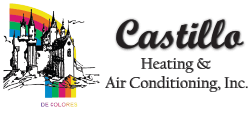Most Common Heater Problems
In Southern California, we are lucky enough to not have to worry too much about heating. But the beauty about living here is that we have the beach and the snowy mountains just a drive away, and some of our homes experience a chilly drop in temperature during the night. We are so used to doing everything we can to take care of our valued air conditioning that sometimes we overlook the problems that can happen with our heaters. To make sure your family and guests have a cozy comfortable holiday season, here are a few of the most common types of problems that people experience with their heaters.
How Your Heater Works
Your heater, or furnace, is a unit of your complete HVAC system. To troubleshoot heating problems, we have to first understand how it works within your system.
Furnaces commonly use gas to heat air before distributing it throughout your home using air ducts. This works through a specific sequence of operations:
- Your thermostat communicates the start signal to your furnace to reach the designated temperature.
- The control board receives the signal from the thermostat and performs a safety check on the limit switches and roll out switches.
- Once the safety check is successfully completed, the inducer motor comes on.
- After the inducer motor comes on, the pressure switch has to shut off so that the igniter can spark and start to heat up.
- The gas valve then opens up to ignite the burner underneath the combustion chamber. The gas valve works with the thermostat to regulate gas flow to the furnace.
- Flames heat the metal heat exchanger, which is continued until the heat is transferred to the surrounding air.
- The flame sensor monitors the flame for 30 seconds before the blower motor turns on. The blower motor moves hot air through the plenum where it is then distributed throughout the home or building through air ducts.
- Once the thermostat temperature is satisfied, the burner shuts off.
Common Causes of Heater Problems
After seeing how many components are involved in your furnace’s operation, it’s easy to see how one malfunction can disrupt your source of heat. If you suddenly find yourself without heat, you may want to troubleshoot some common problems if your local HVAC contractor is booked or if you want to save on money before calling a contractor to your house to perform a diagnostic on your system. Below we list some of the most common problems that people run into with their furnaces.
Heater Symptom: Heat comes on but doesn’t stay on; heat shuts off after a short time of being on.
Problem Cause: Lack of Maintenance
If your HVAC system is not properly maintained throughout the year, you’re likely to run into problems when you first turn on your heater for the winter.
- Air filters should be changed once a month or as needed depending on the amount of dust and dander build-up you experience in your home. If you neglect to change your filter, dust and other particles will plug it up, disrupting airflow and causing your system to overwork. System overwork can cause safety tri-limit switches to trip.
- Dust can also accumulate on the burners. If the burners get too dirty, it can cause complications with the system igniting and burning properly. This can also cause further damage to igniters, pilots, and flame sensors.
This can be prevented by reading up on the manual for your unit and maintaining it regularly. Make sure filters are cleaned or replaced as needed and that the area around your furnace is kept clean and free of clutter and debris.
Heater Symptom: Furnace won’t come on.
Problem Cause: Bad Igniter
The igniter is what heats the burner and gets your furnace working. If there is a problem with the igniter, your furnace won’t be able to operate to heat your home.
- Without proper maintenance, the area around you igniter can build up dust and debris, which will make it harder to ignite and cause it to burn out.
- The age of your system or neglect leads to wear and tear on the components of your furnace, including the igniter. An old or overused igniter will go out, stopping your furnace from heating up.
It is recommended that you call a professional HVAC technician to maintain your system once a year. Although you can clean the area around the igniter yourself, a professional can use their knowledge and experience to check components of your heater if they are going bad. Remember to schedule maintenance visits BEFORE the busy season so that you heater is ready to go before it gets cold.
Heater Symptom: I turned the temperature up, but nothing happens.
Problem Cause: Bad Thermostat
Your thermostat is the first component in the system operation of your heater. If the thermostat is not functioning properly, there will be no communication to get your furnace to turn on or adjust temperature.
- Thermostats are connected to your system electronically through wiring in the wall. Power surges can burn out some of these fuses and wires, disabling your thermostat.
- Most thermostats go out because of wear and tear. Age and use over the years can make buttons stick or other components stop working properly. Updating your thermostat can solve this problem as new energy efficient and programmable thermostats can prevent your system from overworking, thus prolonging the life span of your system.
Some recommendations about thermostats is to have a digital thermostat installed since they tend have more accurate temperature readings and cost less to operate in the long run. Programmable thermostats also allow you to set up heating schedules so that your system cycles efficiently and doesn’t overwork, prolonging the life span of your system. Surge protectors can also be installed to prevent damage to wires in case of power surges.
Heater Symptom: I can hear my heater try to come on, but it doesn’t come all the way on.
Problem Cause: Bad Control Board
The control board is another vital part of system communication from your thermostat to you heater. It receives the signal from the thermostat to start the heater and then performs a safety check on the switches before initiating the heating operations. If your control board is damaged or in poor condition, your furnace will not completely turn on.
- Power surges can also affect control boards, shorting out wires and burning the board.
- Age and overuse causes wear and tear on the control board, so regular maintenance and proper operation of your system will prolong the lifespan of your control board and the rest of your system.
- Your control board is located near the furnace, so if you have a rodent infestation, there is a high chance that they will chew through the low voltage wires, causing them to short out and burning the board.
Again, proper maintenance and operation of your system is vital to preventing problems with your heater and avoiding these repairs. Surge protectors help prevent power surge damage to your board. If you see any sign of rodent infestation, take care of the problem immediately to avoid further damage to your HVAC system.
*Remember that these are all trouble-shooting guidelines but they do not guarantee that they are the definitive problem causing you heater to malfunction. Filters can be cleaned or replaced, thermostat batteries can be changed, but it is not recommended that you replace thermostats or control boards on your own if you are not experienced with their wiring. You can buy thermostats at hardware stores and installed, but we recommend hiring a professional to install them as improper installation can cause fuses to burn out. Control boards are more difficult to get, as your unique system will require a specific model of control board depending on brand and model number. They are also more complicated to install and require more extensive knowledge and experience. We highly recommend that you call a professional to install a control board for safety and operational reasons.
The more that you know about your system and how it works, the better you can take care of it and prevent it from breaking down. As a well-oiled machine, your HVAC system can last you through many holiday seasons, keeping you and your loved ones warm and cozy. Remember to take care of maintenance every year with a professional servicing and to not over work or abuse your properly-sized system. If you have any questions about this information, or if you need to schedule service for your HVAC system, call Castillo Heating & Air Conditioning and ask about our biannual maintenance service.
You May Also Like

Diagnosing 4 Worrisome Ductless Noises in Canyon Lake, CA
When running the ductless HVAC system in your Canyon Lake, CA, home, you should be able to sleep soundly without trouble. If… Continue Reading Diagnosing 4 Worrisome Ductless Noises in Canyon Lake, CA…

How Commercial HVAC Breakdowns Impact Your Business
In the picturesque business landscape of Canyon Lake, CA, a commercial HVAC breakdown is more than an inconvenience. It’s a substantial hit… Continue Reading How Commercial HVAC Breakdowns Impact Your Business…

4 Signs of an Inefficient Furnace in Menifee, CA
When winter rolls around in Menifee, CA, you want to make sure your furnace is operating at peak performance. An inefficient furnace… Continue Reading 4 Signs of an Inefficient Furnace in Menifee, CA…
